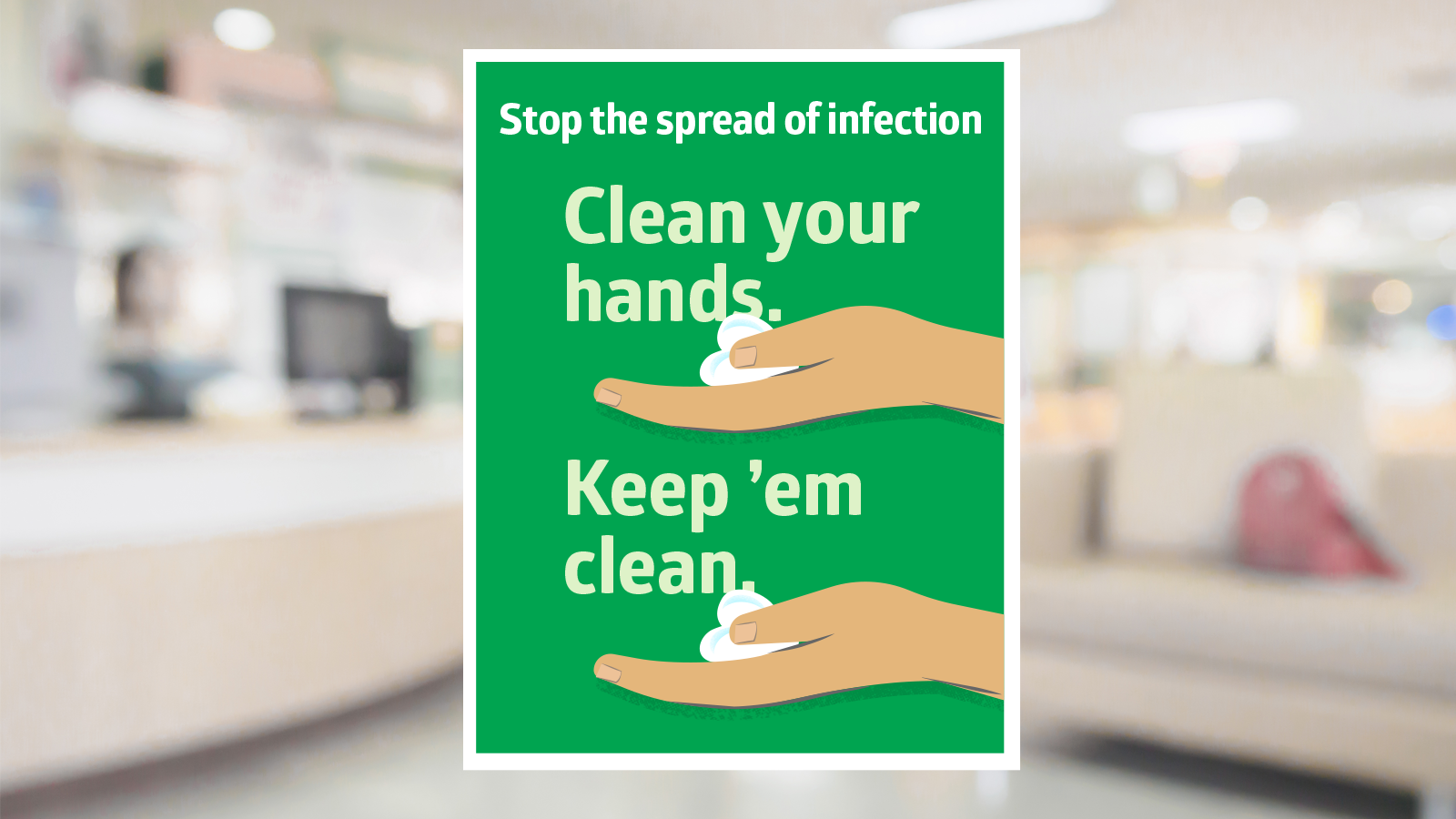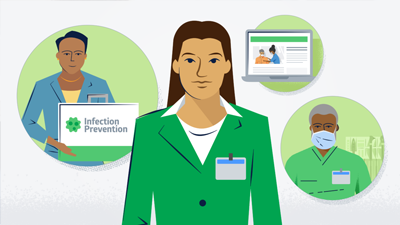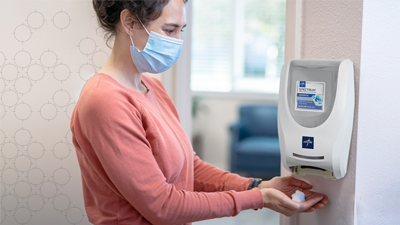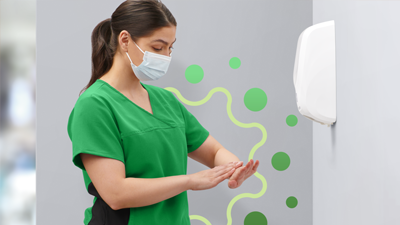You’re working every day to build a strong team defense in the fight against healthcare-associated infections (HAIs). How do you determine weaknesses? To help identify gaps in infection control practices, Medline completed “discovery assessments” with more than 100 long-term care providers across the nation in late 2022.
The goal being, once you assess your risk level, you’re better informed and armed to close those gaps through education, training and other viable solutions.
This article is the second in a five-part series on how to address each of the main infection control challenges identified.
So what did the assessment results show? We asked LTC leaders, “How much do you agree with this statement, ‘We acknowledge we have performance gaps in staff hand hygiene compliance’?” Here’s what we learned:
It’s important to close these gaps: Proper hand hygiene is the number one way to prevent the spread of infection.2
Following are eight strategies for empowering staff to increase hand hygiene in your facility:
1
Educate and train staff using engaging methods and tools.
What can get in the way of someone performing a task? Not understanding the “why.”
Make sure your education and training drive home the potential consequences of not performing hand hygiene: germs spreading from staff hands to residents, causing the residents to develop HAIs—some of which can be life-threatening.
Consider providing a mix of hands-on training, informational workshops, video presentations, printed materials and online courses. And how about using games to help staff retain information?
“For example, you could have cards that outline different scenarios caregivers experience while providing care, such as helping a resident eat a meal, transferring a resident from the bed to a chair, gathering wound care supplies and cleaning rooms,” says Caryn Arnold, MBA, RN, BSN, CNOR(E), a-IPC, Medline Medical Science Liaison. “The caregiver then identifies the correct hand hygiene product to use, detailed on the cards.”3
2
Provide access to hand hygiene products at all touchpoints.
Ensure staff, residents and visitors have easy access to soap and water or alcohol-based hand sanitizers. Products should be in convenient locations throughout the facility, such as near entrances and exits, inside and outside resident rooms and in common areas.
“It’s not always appropriate or safe to place bottled products next to resident beds,” says Arnold. “Residents who are confused or have dementia may not understand its purpose and misuse it or, unfortunately, ingest it.”
Arnold recommends having wall-mounted dispensers outside of resident rooms and providing staff with portable containers of hand sanitizer that they can carry with them. In addition, you’ll want to use products that are non-drying and promote skin health to encourage use.
3
Provide encouragement and reminders.
Use visual cues and reminders, such as posters and signs, to encourage staff and residents to perform hand hygiene. Examples include:
- Display “Clean Hands Save Lives” posters near hand hygiene stations and in common areas to remind staff and residents of the importance of hand hygiene
- Place “Wash Your Hands” signs near sinks and hand hygiene stations that instruct on the proper technique for handwashing
- Display “Hand Hygiene is a Team Effort” posters that encourage staff and residents to work together to maintain good hand hygiene practices
4
Emphasize how to keep hands germ-free.
“We also need to change people’s behavior after they’ve cleaned their hands,” says Arnold. “For example, if a caregiver performs hand hygiene, starts helping a resident dress and then touches their phone or another item, their hands are no longer clean.”
But they have in their head, “I did hand hygiene.” They don’t consider these other actions as creating opportunities for contamination. So what not to do has to be drilled into people in an educational, non-punitive way: Don’t touch your face, your hair, your phone, the bedside table. Pay attention to the order in which you open supplies so you don’t contaminate anything, Arnold adds.
We also need to change people’s behavior after they’ve cleaned their hands.

Caryn Arnold, MBA, RN, BSN, CNOR(E), a-IPC
Medline Medical Science Liaison
5
Involve staff, residents and family caregivers.
Encourage residents to clean their hands and remind staff when hand hygiene is not performed. Promote a culture where speaking up is accepted and encouraged. Empower staff in efforts to improve hand hygiene compliance by providing opportunities for feedback and input on hand hygiene practices.
And what about recognizing staff and residents for their efforts?
Consider hosting recognition events, such as staff appreciation lunches or awards ceremonies. Provide staff members and residents certificates of recognition or commendations. You could also post the names of staff members who consistently demonstrate good hand hygiene practices on a breakroom bulletin board or in an internal newsletter.
Remember to include residents and family caregivers in education on why hand hygiene is important and the proper way to perform it. And encourage them to participate in monitoring hand hygiene compliance and evaluating the effectiveness of corrective actions.
6
Monitor and evaluate compliance.
You’ll want to regularly monitor hand hygiene compliance and evaluate the effectiveness of interventions. This can help identify areas for improvement and ensure that efforts to increase hand hygiene compliance are ongoing.
Use monitoring tools such as checklists to track and report on hand hygiene compliance. You also could use hand hygiene monitoring apps, many of which are free. Or consider using electronic monitoring systems. Provide timely feedback to staff and residents on hand hygiene performance, praising them on what they’re doing right and providing constructive guidance when improvement is needed.
Finally, continuously evaluate and improve hand hygiene practices, incorporating new guidelines and best practices as they become available.
7
Engage leadership and ensure you have their support.
Do your facility leaders understand the importance of hand hygiene and its impact on resident/staff safety and well-being?
You’ll want to educate them and demonstrate the impact. For example, provide leaders with data and research on the impact of hand hygiene on resident health and the prevention of infections. And involve leaders in the development and implementation of hand hygiene initiatives to ensure their buy-in.
Communicate the benefits of improved hand hygiene compliance, such as reduced rates of infections and improved resident outcomes. In addition, share success stories and positive outcomes from hand hygiene initiatives.
8
Collaborate with an industry partner.
Make the most of what your medical supply partner can offer. For example:
- A tailored long-term care program that includes educational resources, such as training materials, posters and brochures, to help staff and residents understand hand hygiene importance and proper techniques
- Supply of high-quality hand hygiene products, ensuring the right on-hand inventory
- Placement of hand hygiene stations throughout the facility
- Ongoing support and evaluation to help you assess the effectiveness of your facility’s hand hygiene efforts and identify areas for improvement
Key takeaway
Proper hand hygiene is the number one way to prevent the spread of infection, so it’s important to close gaps in your facility. When you provide the right education in the right way to staff, residents and family caregivers; provide appropriate access to products; provide encouragement and reminders; monitor and evaluate compliance; engage leaders; and collaborate with your industry partner, you’ll be taking the right steps to enhance your culture of safety. Stay tuned for the third installment of this article series.
References:
- Medline 2022 Long-Term Care Discovery Assessment Findings. Data on file.
- APIC. Hand Hygiene. Retrieved February 15, 2023, from Hand Hygiene – APIC.
- Arnold, C. (2023, February 8). You got game: How fun benefits continuing education. McKnight’s Long-Term Care News. You got game: How fun benefits continuing education – Marketplace Experts – McKnight’s Long-Term Care News (mcknights.com)







